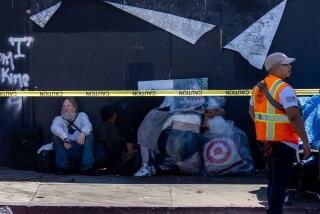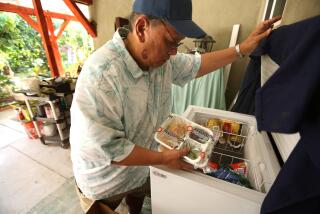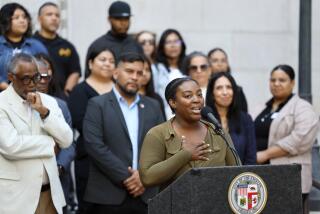A Testing Ground in Welfare Reform
- Share via
The hotel room in the middle of downtown Los Angeles’ skid row is spare: a double bed, blank walls and a window overlooking the wall of the building next door.
But for Michael Ugarte it beats the abandoned couch in a Santa Monica back alley that was home for weeks while he was living on the streets.
After decades of fighting a substance abuse problem that had constricted his life like a python, Ugarte, 41, has been clean for nine months and is trying to get back on his feet.
But he fears that it may all come undone if the Los Angeles County Board of Supervisors moves Tuesday to cut off the $212 monthly General Relief check that is his only means of support.
“Any cutback would put me right back on the streets,” said Ugarte, sitting in a lounge area of the Marshall House, a 71-room single-occupancy hotel that charges $136 a month. In a freshly pressed shirt, chinos and stylish loafers, he looks like the young real estate professional that he was until last July when he lost his job.
The board Tuesday is scheduled to take final action on the most severe restrictions yet considered in its General Relief program short of abandoning it altogether: a proposal to limit aid checks to four months in any 12-month period and to require treatment for substance abusers.
Officials say the about $40 million in annual savings will help to cover the costs of a state appellate court finding that between 1993 and 1995 the county wrongfully reduced General Relief’s monthly $285 cash grants by $73. The court ordered that the retroactive benefits--which could total $136 million--be paid to recipients.
The county is appealing the judgment to the state Supreme Court.
Beyond the local political wrangling and implications for Los Angeles aid recipients, the proposed restrictions point up many of the challenges faced by public officials as they attempt to restructure welfare policies that have been in place for decades.
The attempt by the largest county government in the nation to severely curtail the only welfare program aimed specifically at single adults raises questions about the possible wider repercussions to society of the current wave of welfare reform efforts.
General Relief is considered the public aid of last resort, intended for single, childless adults who do not qualify for other cash assistance programs. Recipients qualify for $212 monthly for housing and personal care needs, limited medical care benefits and food stamps of up to $119 each month.
Of about 90,000 General Relief recipients, about 60% are considered employable and must enroll in a work program, performing custodial or clerical services for government agencies. The remainder are considered unemployable because of disabilities and would continue to receive checks.
But even the able-bodied recipients have complex social, economic and health care needs. A typical person gets aid for six months, but almost half have fallen back on the dole after 12 months. The population is 60% male and includes every race and ethnic group. Recipients often have a wealth of work experience, but they are an aging group--the average age of men is 39, and of women, 44--that is hard-pressed to compete on the job market.
*
The county’s proposal is controversial within government circles. The restrictions were proposed by lawyers in the county counsel’s office as a way to pay for the court decision, despite recommendations by top officials within the county’s Social Services Department that no cutoffs be made.
The cutoff is also fraught with uncertainties.
It is unclear what proofs would be required to determine substance abuse and who would screen recipients, although county officials say that job would probably fall to the Department of Health Services rather than social service workers. Of larger concern is the acknowledged lack of space in treatment facilities, where waits can extend to three months, advocates said.
Alice Callaghan, president of Skid Row Housing Trust, recounted the ordeal of time and money spent trying to find a space in a drug treatment program for one person in her program. And experts also question whether mandatory treatment will be effective.
“The spaces are not there, nor will they be there,” said Callaghan said. “It is very costly and will be very costly to create programs for people who want them, let alone people who will be required to get it to stay on G.R.”
County officials acknowledge that they are still trying to create an apparatus to deal with the issue.
Officials also acknowledge that the 50,000 able-bodied recipients have become an important part of the public work force, especially for departments like Beaches and Harbors and Parks and Recreation.
County officials say they are concerned at the prospect of losing workers now responsible for such community services as keeping parks and beaches clean. But new federal welfare regulations require food stamp recipients to be in workfare programs, and county officials say they believe the loss of workers will not be too great.
Advocates predict that the proposed changes in General Relief will result in an additional 15,000 homeless people in Los Angeles County. The county has not issued its own prediction on the effect.
“Two-thirds of the G.R. population is homeless at some point during the month anyway and this will just add to the problem,” said Bob Erlenbusch, president of Los Angeles Coalition to End Hunger and Homelessness. “They will be recycling more cans, begging, stealing. It puts the L.A. City Council anti-panhandling ordinance efforts at odds.”
Already, many recipients double and even triple-up at the downtown single-occupancy hotels where many of them reside.
The hotels--some privately run, others nonprofit--may be hard hit. The owner of the 450-room Frontier Hotel is increasing the number of rooms that will be rented to two or more people in anticipation of the supervisors voting to further restrict General Relief, owner Rob Frontiera said.
“Starting Monday, we’re offering more than 200 rooms as shared units,” Frontiera said. Rooms with baths at the hotel at 5th Street and Main Avenue rent from $189 a month up to $340.
Other hotel owners are apparently getting out of the business altogether.
Charles “Bud” Hayes, president of the SRO Housing Corp., a nonprofit group that operates the Marshall House and several other hotels, said he is getting three to four calls weekly from real estate agencies with hotels on the market in downtown and other areas like Pico-Union and East Los Angeles.
The nonprofits are frequently sought out to take over hotels because they can offer lower rents than for-profit owners. But many nonprofits have taken out loans to build and improve facilities and their ability to pay back those loans are affected by their rental income, Callaghan said.
Hayes worries that the proposed General Relief restrictions could trigger a scenario affecting attempts to rehabilitate downtown Los Angeles: a large number of General Relief recipients being forced into the streets; landlords unable to replace them; properties foreclosed on; building sitting vacant; the inevitable encampments of squatters.
“You could get the kind of cycle you’ve seen in Detroit or New York,” Hayes said.
The cumulative effect could reach beyond downtown. Bob Stone, an independent housing management consultant who has done studies for the city, noted that areas such as Westlake and MacArthur Park where many efficiency units are located are among the most densely populated in the country.
Michael Ugarte found his room in the Marshall House two weeks ago and feels lucky to have it, he said. His $136-a-month rent includes breakfast and lunch served at the nearby Weingart Center.
“It’s a decent amount, and I can have enough left over for little necessities, things for hygiene. My friends gave me clothes,” he said.
He attends two counseling sessions a day at the Veterans Affairs outpatient clinic on Temple Street, where he also serves as a volunteer. His father lives in Los Angeles, as do a couple of sisters, but it is hard depending on his family for help, he said.
*
“My father left home when I was 2,” he says. “We’re closer now, but he’s an old-fashioned, you-got-to-do-it-for-yourself guy. My sisters have families of their own.”
But the family has grown closer in recent months as Ugarte has sought help for his drug and alcohol problems. His troubles started 25 years ago as a 17-year-old Marine recruit. He had smoked a few joints in high school, but it was while in the Marines, serving in North Carolina and in the South China Sea during the pullout from Vietnam, that he was introduced to hard stuff like cocaine, he says.
Since then, it has been one long fight, in one job for a few years and then overcome by addiction. Last July, he hit bottom, losing his Glendale real estate job and his Glassell Park home.
Ugarte wants to return to school, to learn computer and other technical skills. But he expects to be in his present room for up to a year, if he can keep his benefits. He wants to hang a few pictures, buy some plants. The heart of skid row can provide perspective, he said.
“Some other people might mind, but for me it kind of reminds me of where I could be. It’s a good reality check.”
More to Read
Sign up for Essential California
The most important California stories and recommendations in your inbox every morning.
You may occasionally receive promotional content from the Los Angeles Times.











